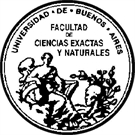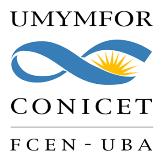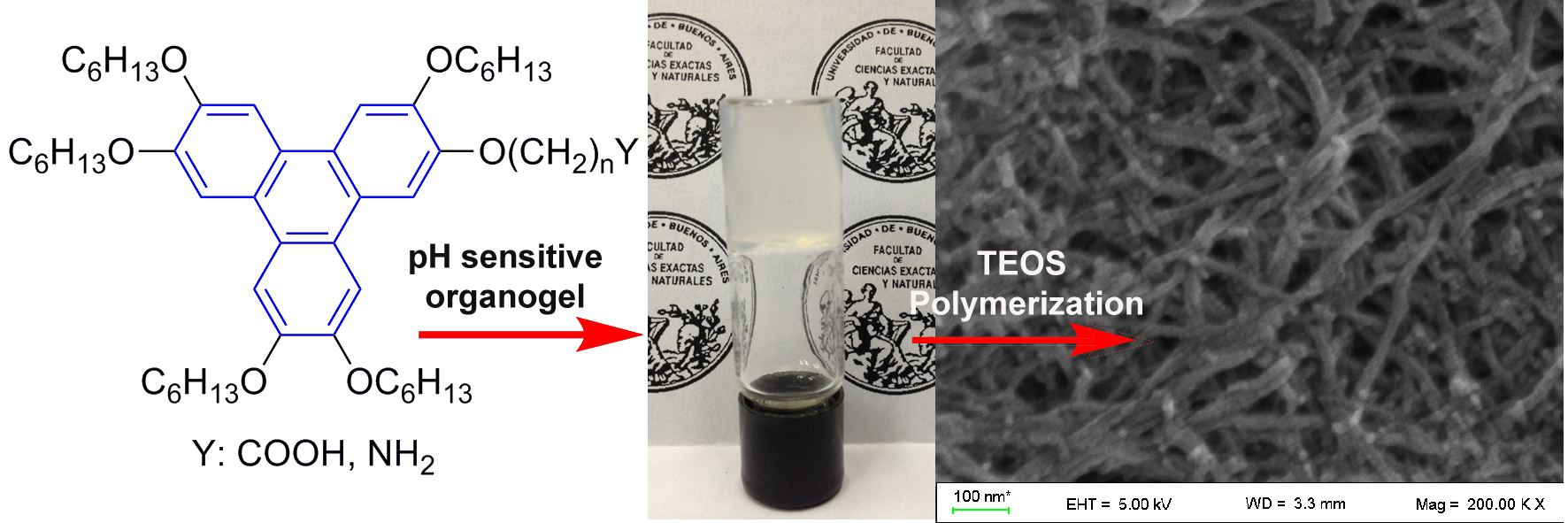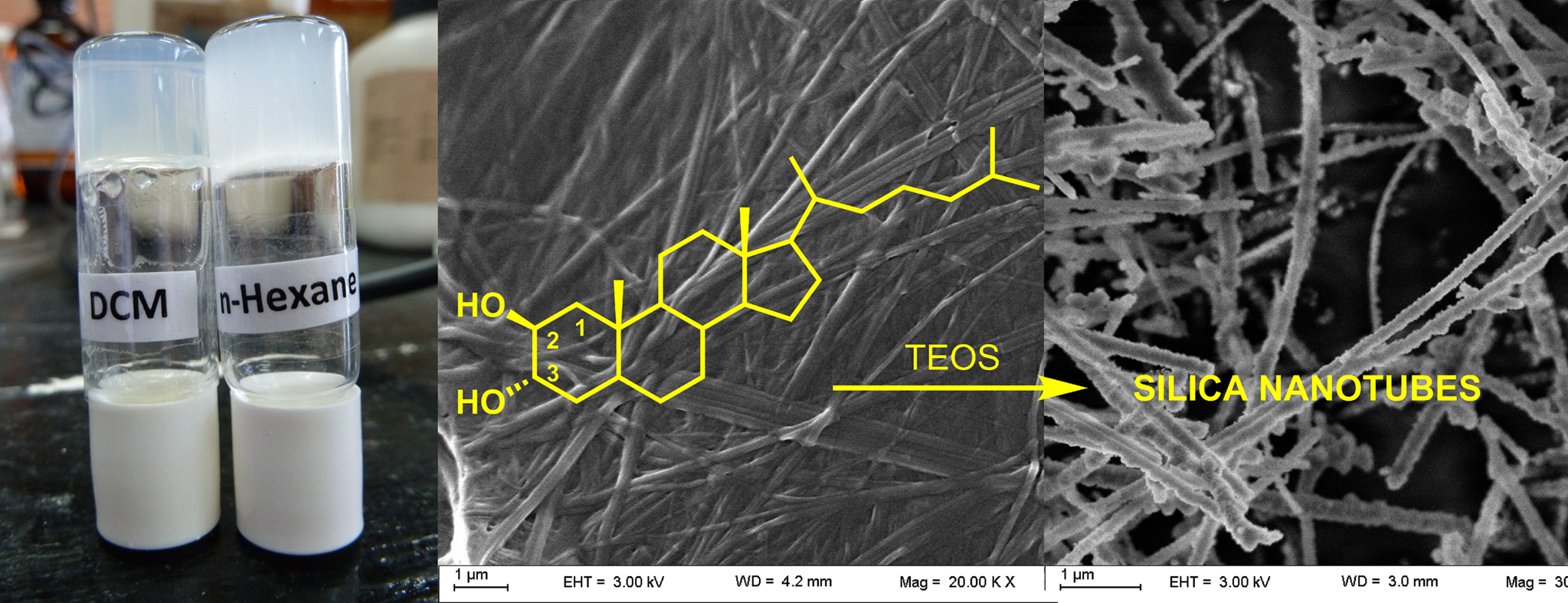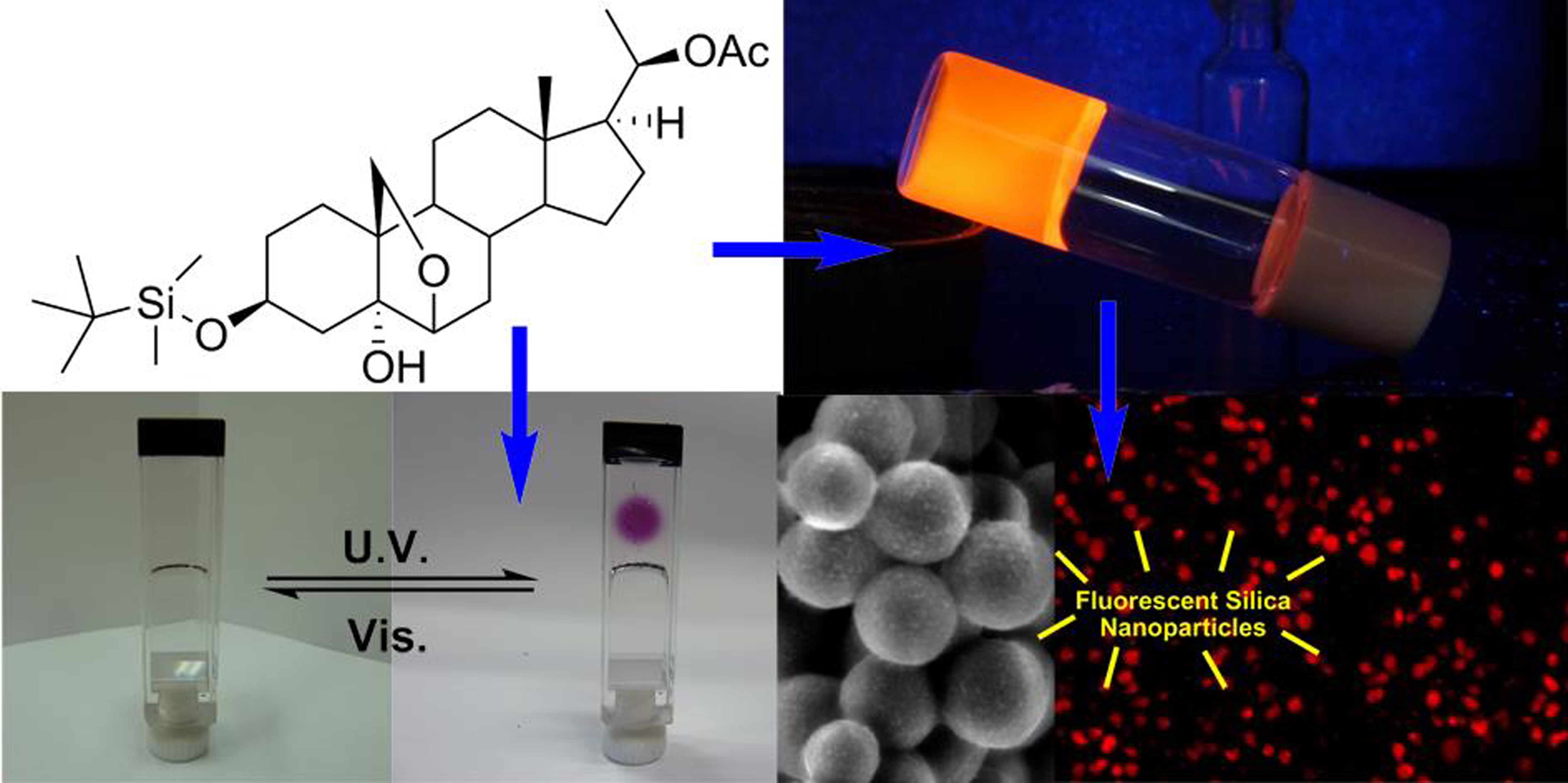Welcome to Pablo H. Di Chenna`s Group site
Research and Publications
Current Research Area
Physical gels based on low molecular weight gelators (LMWG) and a liquid (organic solvent or water) are formed through cooperative non covalent supramolecular interactions leading to a 3D self-assembled network that traps the solvent. Their relevance is related to their unique properties as functional materials and their many potential high-tech applications. The formation of the gel involves a delicate balance of cooperative forces between the directional self-assembly that promotes the aggregation and the solubility in the given solvent, which is based on the specific interactions between solvent and gelator molecules. Although a great effort has been made to investigate the structure–property relationships and the gelation process, it is still not possible to design a new LMOG de novo and the gelation process is poorly understood.

Our research interests are focused on the rational development of new low molecular weight gelators and the study and characterization of their functional gels. The research project involves from the design and synthesis of new small molecular weight gelators to the physicochemical characterization of their gels. The main goal is to understand the structure-property relationship in order to rationally design new LMOGs and create functional soft materials with interesting chemical and/or physical properties. In particular our current research is centered on aromatic pi-gelators, the study of their electronic associated properties (fluorescence, electric conductivity, etc.) and their use as molecular template for the preparation of inorganic nanostructured materials such as fibers, ribbons, sheets, helical structures, etc.
J. sol-gel Scie. Technol. 2021.
Evelyn L. Bonifazi, Andrea S. Mac Cormack, Verónica M. Busch, M. Laura Japas, Lorenzo Di Bari, Pablo H. Di Chenna*
Chiral self-assembly and water effect on a supramolecular organogel stable towards Aqueous Interfaces
https://doi.org/10.1007/s10971-021-05550-w
Org. Biomol. Chem., 2021, 19, 6455
Alejandro E. Cristófalo, Pedro M. Nieto, Michel Thépaut, Franck Fieschi, Pablo H. Di Chenna, María Laura Uhrig*
Synthesis, self-assembly and Langerin recognition studies of a resorcinarene-based glycocluster exposing a hyaluronic acid thiodisaccharide mimetic.
DOI: 10.1039/d1ob00895a
New J. Chem., 2020, 44, 8198-8208
A. Mac Cormack, V. Busch, M. Japas, L. Giovanetti, F. Di Salvo, P. H. Di Chenna.
The effect of vicinal di-halo substituents on the organogelling properties of aromatic supramolecular gelators and their application as soft templates
doi.org/10.1039/D0NJ01440K
New J. Chem., 2020, 44, 2423-2434
N. Vadra, C. Huck-Iriart, L. J. Giovanetti, P. H. Di Chenna, F. D. Cukiernik.
Supramolecular organogels based on mesogenic 2,7-difunctionalized triphenylenes as a simple system for water content assessment in light alcohols.
doi.org/10.1039/C9NJ04834K
Carbohydrate Research 2019, 6-12.
H.O. Montenegro, P.H. Di Chenna, C.C. Spagnuolo, M. L. Uhrig.
Multivalent assembly of a pyrene functionalized thio-N-acetylglucosamine: Synthesis, spectroscopic and WGA binding studies.
doi.org/10.1016/j.carres.2019.04.010.
Org. Biomol. Chem., 2019
María I. Lapuh, Alejandro Dana, Pablo H. Di Chenna, Benjamin Darses, Fernando J. Durán, Philippe Dauban.
Late-stage C–H amination of abietane diterpenoids
DOI: 10.1039/C9OB00272C
New Journal of Chemistry, 2017, 41, 14754
María E. Cano, Pablo H. Di Chenna, David Lesur, Alejandro Wolosiuk, José Kovensky, María L. Uhrig.
Chirality inversion, supramolecular hydrogelation and lectin binding of two thiolactose amphiphiles constructed on a di-lauroyl-L-tartaric acid scaffold.
DOI: 10.1039/C7NJ02941A
Steroids 2017, 121, 40-56. https://authors.elsevier.com/a/1UlVX,uy65TEZ
Virginia Dansey, Celeste Del Fueyo, Adriana S. Veleiro, Pablo H. Di Chenna
Synthesis of new C-25 and C-26 steroidal acids as potential ligands of the nuclear receptors DAF-12, LXR and GR.
DOI:10.1016/j.steroids.2017.03.003
J. Mater. Chem. C, 2016, 4, 7035-7042.
Luciana C. Schmidt, Valeria C. Edelsztein, Carla C. Spagnuolo, Pablo H. Di Chenna, Raquel E. Galian
Light-responsive hybrid material based on luminescent core-shell quantum dots and steroidal organogel.
doi: 10.1039/C6TC02265K
Gels 2016, 2(1), 7
Ignacio Muñoz Resta, Verónica E. Manzano, Florencia Cecchi, Carla C. Spagnuolo, Fabio D. Cukiernik , Pablo H. Di Chenna.
Supramolecular Assembly of pH Sensitive Triphenylene Derived pi-Gelators and Their Application as Molecular Template for the Preparation of Silica Nanotubes.
doi:10.3390/gels2010007
ACS Appl. Mater. Interfaces. 2014, 6, 8933−8936
Bonifazi, Evelyn; Edelsztein, Valeria; Menendez, Guillermo; Samaniego López, Cecilia; Spagnuolo, Carla; Di Chenna, Pablo H.
Versatile Supramolecular Organogel with Outstanding Stability towards Aqueous Interfaces.
doi: 10.1021/am5010656
Beilstein J. Org. Chem. 2013, 9, 1826-1836
V. C. Edelsztein, A. S. Mac Cormack, M. Ciarlantini, P. H. Di Chenna
Self-assembly of 2,3-Dihydroxycholestane Steroids into Supramolecular Organogels as a Soft Template for the in-situ Generation of Silicate Nanomaterials.
doi: 10.3762/bjoc.9.213
Steroids 2013, 78, 34-36
M. D. Martinez, V. C. Edelsztein, F. J. Duran, P. H. Di Chenna, G. Burton.
Synthesis of 6-Azaprogesterone and 19-Hydroxy-6-azasteroids.
doi: 10.1016/j.steroids.2012.10.012
J. Mat. Chem. 2012, 22, 21857-21861
Valeria C. Edelsztein, Elizabeth A. Jares-Erijman, Klaus Müllen, Pablo H. Di Chenna,
Carla C. Spagnuolo Título: A Luminescent Steroid-Based Organogel: ON–OFF Photoswitching by Dopant Interplay and Templated Synthesis of Fluorescent Nanoparticles.
doi: 10.1039/C2JM34891H
Bioorg. And Med. Chem. 2011, 19(5), 1683-1691
Alvarez, L.D., Dansey, M.V., Martí, M.A., Bertucci, P.Y., Di Chenna, P.H., Pecci, A., Burton, G.
Biological Activity and Ligand Binding Mode to the Progesterone Receptor of A-homo Analogues of Progesterone.
doi: 10.1016/j.bmc.2011.01.033
Tetrahedron: Asymmetry., 2010, 21, 1447-1457.
Fabien Robert-Peillard, Pablo H. Di Chenna, Chungen Liang, Camille Lescot, Florence Collet, Robert H. Dodd, Philippe Dauban.
Catalytic Stereoselective Alkene Aziridination with Sulfonimidamides.
doi: 10.1016/j.tetasy.2010.03.032
European J. Med. Chem., 2010, 45, 3063-3069
M. Dansey, P.H. Di Chenna, A.S. Veleiro, Z. Krištofíková, H. Chodounska, A. Kasal, G. Burton.
Synthesis and GABAA Receptor Activity of A-Homo Analogues of Neuroactive Steroids.
doi: 10.1016/j.ejmech.2010.03.037
Tetrahedron, 2010, 66, 2162-2167
Edelsztein, V. C.; Burton, G.; Di Chenna, P.H.
Self-assembly of a Silylated Steroid Organogelator and its Use as Template for the in situ Sol-Gel Polymerization of Tetraethyl orthosilicate
doi: 10.1016/j.tet.2010.01.065
Tetrahedron, 2009, 65, 3615-3623
Edelsztein, V. C.; Di Chenna, P. H.; Burton, G.
Synthesis of C-C bonded dimeric steroids by olefin metathesis
doi: 10.1016/j.tet.2009.03.006
Org. Biomol. Chem., 2007, 5, 2453-2457
Pablo H. Di Chenna, Adriana S. Veleiro, Juan M. Sonego, Nora R. Ceballos, M. Teresa Garland, Ricardo F. Baggio, Gerardo Burton
Synthesis of 6,19-cyclopregnanes. Constrained Analogues of Steroid Hormones
doi: 10.1039/B706828J
Arkivoc, 2005, xii, 154-162
P.H. Di Chenna, M.V. Dansey, A. Ghini, G. Burton
Rearrangement of 4b,5b-methylenepregnanes: a simple approach to A-homopregnanes and 5 a -methylpregnanes.
http://www.arkat-usa.org/get-file/19350/
Tetrahedron Lett. 2005, 46, 4235-4238
A.S. Veleiro, P.J. Taich, L.D. Alvarez, P.H. Di Chenna, G. Burton
Synthesis of C(1)-C(11) Oxygen-Bridged Pregnanes
doi: 10.1016/j.tetlet.2005.04.052
Org. Lett., 2004, Vol. 6, 24, 4503-4505
P.H. Di Chenna , F. Robert-Peillard, P. Dauban, R.H. Dodd
Sulfonimidamides: Efficient Chiral Iminoiodane Precursors for Diastereoselective Copper-Catalized Aziridination of Olefines.
doi: 10.1021/ol048167a
Tetrahedron, 2003, 59, 1009-1014
P.H. Di Chenna, P. Dauban, A. Ghini, R. Baggio, M. T. Garland, G. Burton, R. H. Dodd
PhI=Nses Mediated Aziridination of 11-Pregnane Derivatives: Synthesis of an 11,12-Aziridino Analogue of Neuroactive Steroids.
doi: 10.1016/S0040-4020(02)01655-1
J. Chem. Soc. Perkin Trans I, 2002, 2, 227-231
P.H. Di Chenna, A. Ferrara, A. Ghini y G. Burton,
Cleavage of Cyclopropyl Ketones Mediated by Alkyl Mercury(II)
doi: 10.1039/B107258G
J. med. Chem., 2001, Vol44, 15, 2486-2489
P.H. Di Chenna, V. Benedetti-Doctorovich, R.F. Baggio, M. T. Garland, Gerardo Burton.
Preparation and Cytotoxicity toward Cancer Cells of Mono(arylimino) Derivatives of b-Lapachone
doi: 10.1021/jm010050u
Tetrahedron letters, 2000, 41, 7041-7045
P.H. Di Chenna, P. Dauban, A. Ghini, G. Burton, R. H. Dodd
Aziridination of 11-Pregnene-3,20-dione Using PhI=N-Ses.
doi: 10.1016/S0040-4039(00)01228-4
Recent and ongoing projects
Ongoing Projects:
- Design, synthesis and study of low molecular weight organogelators oriented to the preparation of inorganic and hybrid nanostructured materials
- Design, synthesis and study of pi-gelators and the characterization of their electronic properties.
Recent Projects
-Design, synthesis and characterization of steroidal supramolecular gelators.
Selected Publications
-------------------------------------------------
